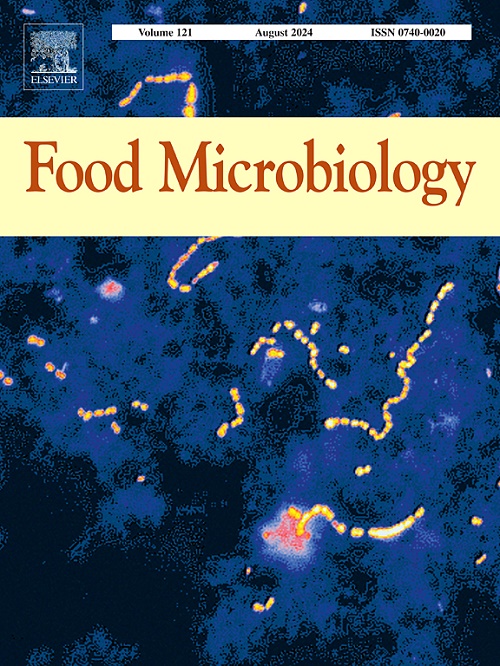Physical fields reverse FeSO4-induced VBNC state in Listeria monocytogenes and facilitate ferroptosis
IF 4.5
1区 农林科学
Q1 BIOTECHNOLOGY & APPLIED MICROBIOLOGY
引用次数: 0
Abstract
Non-thermal sterilization methods are effectively in eliminating foodborne pathogens while preserving the appearance and quality of food. In this study, three physical fields, magnetic field (MF), ultrasound (US), and blue light (BL), were introduced for their efficacy in sterilizing FeSO4-induced viable but non-culturable (VBNC) Listeria monocytogenes (L. monocytogenes) cells over a 4 h treatment. The Fe-MF treatment induced L. monocytogenes cells to form VBNC state, resulting in an 80.13 % reduction in culturable cells, with a 90.58 % survival rate. The ultrasound-assisted FeSO4 (Fe-US) treatment reduced the VBNC cell population by 52.63 %. In contrast, the blue light-assisted FeSO4 (Fe-BL) treatment reversed the VBNC state toward culturable state at the node of 3 h, and induced irreversible 100 % cell death at 4 h, with a 94.73 % decrease in viability and 68.2 % membrane damage. Additionally, Fe-BL treatment led to cell wrinkling and secretion aggregation. BL treatment alone compromised membrane permeability and triggered intracellular protein aggregation. Mechanistic investigations revealed that BL-assisted treatment disrupted the protective mechanism of L. monocytogenes when induced by FeSO4 to form VBNC state, compromised VBNC cell membranes, promoted intracellular Fe2+ accumulation, and induced a reactive oxygen species (ROS) burst and lipid peroxidation, ultimately leading to ferroptosis. Proteomic analysis identified 240 upregulated and 376 downregulated differentially expressed proteins, highlighting significant changes in pathways related to ribosome biosynthesis (related genes rplJ and hpf significant upregulated), intracellular iron homeostasis (ctaB, hemN, and lmo2590 downregulated), cellular morphology (mreB and tagH downregulated), oxidative stress response (lmo0720 and lmo0799 downregulated), and DNA synthesis (recA, dnaD, yidC2 and fruB downregulated). In conclusion, Fe-BL treatment effectively disrupted VBNC cell membranes, induced iron homeostasis imbalance, and triggered Fenton reaction-mediated ferroptosis. These findings provide a promising non-thermal sterilization strategy for inactivating VBNC L. monocytogenes, offering potential applications in food safety.

物理场逆转feso4诱导的单核增生李斯特菌的VBNC状态,促进铁死亡
非热灭菌方法可以有效地消除食源性病原体,同时保持食品的外观和质量。本研究采用磁场(MF)、超声(US)和蓝光(BL)三种物理场对feso4诱导的活但不可培养(VBNC)单核增生李斯特菌(L. monocytogenes)细胞进行了4小时的灭菌效果研究。Fe-MF处理诱导单核增生乳杆菌细胞形成VBNC状态,可培养细胞减少80.13%,存活率为90.58%。超声辅助FeSO4 (Fe-US)处理使VBNC细胞数量减少52.63%。蓝光辅助FeSO4 (Fe-BL)处理可使细胞在3 h后恢复到可培养状态,4 h后细胞100%不可逆死亡,细胞活力下降94.73%,膜损伤68.2%。此外,Fe-BL处理导致细胞起皱和分泌物聚集。单独的BL处理会破坏膜的通透性并引发细胞内蛋白聚集。机制研究表明,bl辅助处理在FeSO4诱导单核增生乳杆菌形成VBNC状态时,破坏了其保护机制,破坏了VBNC细胞膜,促进细胞内Fe2+积累,诱导活性氧(ROS)爆发和脂质过氧化,最终导致铁死亡。蛋白质组学分析发现240个差异表达蛋白上调,376个差异表达蛋白下调,突出了核糖体生物合成(相关基因rplJ和hpf显著上调)、细胞内铁稳态(ctaB、hemN和lmo2590下调)、细胞形态(mreB和tagH下调)、氧化应激反应(lmo0720和lmo0799下调)和DNA合成(recA、dnaD、yidC2和fruB下调)相关途径的显著变化。综上所述,Fe-BL处理有效地破坏了VBNC细胞膜,诱导铁稳态失衡,引发Fenton反应介导的铁凋亡。这些发现为灭活VBNC单增乳杆菌提供了一种有前途的非热灭菌策略,在食品安全方面具有潜在的应用前景。
本文章由计算机程序翻译,如有差异,请以英文原文为准。
求助全文
约1分钟内获得全文
求助全文
来源期刊

Food microbiology
工程技术-生物工程与应用微生物
CiteScore
11.30
自引率
3.80%
发文量
179
审稿时长
44 days
期刊介绍:
Food Microbiology publishes original research articles, short communications, review papers, letters, news items and book reviews dealing with all aspects of the microbiology of foods. The editors aim to publish manuscripts of the highest quality which are both relevant and applicable to the broad field covered by the journal. Studies must be novel, have a clear connection to food microbiology, and be of general interest to the international community of food microbiologists. The editors make every effort to ensure rapid and fair reviews, resulting in timely publication of accepted manuscripts.
 求助内容:
求助内容: 应助结果提醒方式:
应助结果提醒方式:


